Young’s Double-Slit Experiment
The wave theory of light came to prominence with Thomas Young’s double-slit
experiment, performed in 1801. We mention this because it is often called
“Young’s double-slit experiment,” and you’d best know what
Physics means
if it refers to this experiment. The double-slit experiment proves that light
has wave properties because it relies on the principles of constructive
interference and destructive interference, which are unique to waves.
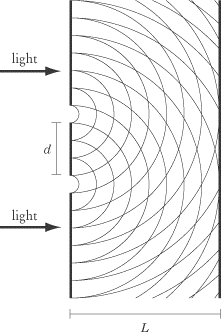
The double-slit experiment involves light being shone on a screen with—you
guessed it—two very narrow slits in it, separated by a distance
d. A second screen is set up a
distance L from the first screen,
upon which the light passing through the two slits shines.
Suppose we have coherent light—that is, light of a single wavelength
?,
which is all traveling in phase. This light hits the first screen with the two
parallel narrow slits, both of which are narrower than
?.
Since the slits are narrower than the wavelength, the light spreads out and
distributes itself across the far screen.
At any point P on the back screen,
there is light from two different sources: the two slits. The line joining
P to the point exactly between the
two slits intersects the perpendicular to the front screen at an angle
?.
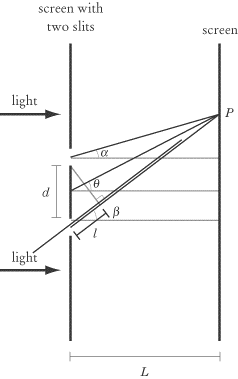
We will assume that the two screens are very far apart—somewhat more precisely,
that L is much bigger than
d. For this reason, this analysis is
often referred to as the “far-field approximation.” This approximation allows us
to assume that angles
a
and
ß,
formed by the lines connecting each of the slits to
P, are both roughly equal to
?.
The light from the right slit—the bottom slit in our diagram—travels a distance
of l =
d sin?
more than the light from the other slit before it reaches the screen at the
point P.
As a result, the two beams of light arrive at P
out of phase by d sin?.
If d sin?
= (n + 1/2)?,
where n is an integer, then the two
waves are half a wavelength out of phase and will destructively interfere. In
other words, the two waves cancel each other out, so no light hits the screen at
P. These points are called the
minima of the pattern.
On the other hand, if d sin?
= n?,
then the two waves are in phase and constructively interfere, so the most light
hits the screen at these points. Accordingly, these points are called the
maxima of the pattern.
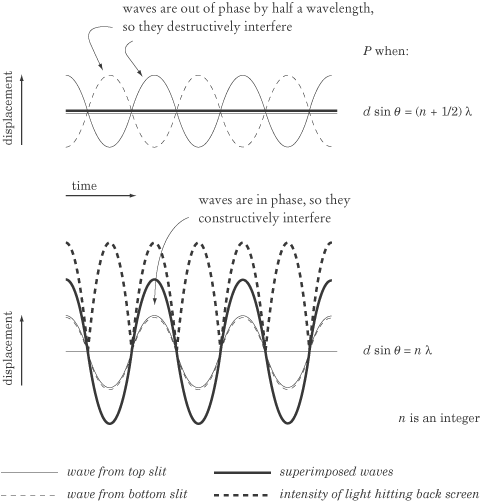
Because the far screen alternates between patches of constructive and
destructive interference, the light shining through the two slits will look
something like this:
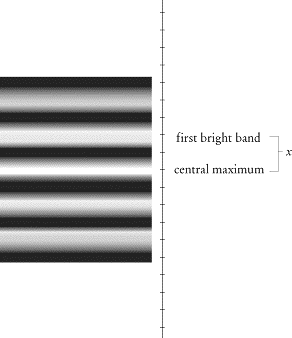
Note that the pattern is brightest in the middle, where
?
= 0. This point is called the central
maximum. If you encounter a question regarding double-slit refraction on the
test, you’ll most likely be asked to calculate the distance
x between the central maximum and
the next band of light on the screen. This distance, for reasons too involved to
address here, is a function of the light’s wavelength (?),
the distance between the two slits (d),
and the distance between the two screens (L):
?/d = x/L
Diffraction
Diffraction is the bending of light around obstacles: it causes interference
patterns such as the one we saw in Young’s double-slit experiment. A
diffraction grating is a screen with a bunch of parallel slits, each spaced
a distance d apart. The analysis is
exactly the same as in the double-slit case: there are still maxima at
d sin?
= n?
and minima at d sin
??
= (n +
1/2)?.
The only difference is that the pattern doesn’t fade out as quickly on the
sides.
Single-Slit Diffraction
You may also find single-slit diffraction on
Physics. The setup is the
same as with the double-slit experiment, only with just one slit. This time, we
define d as the width of the slit
and
?
as the angle between the middle of the slit and a point
P.
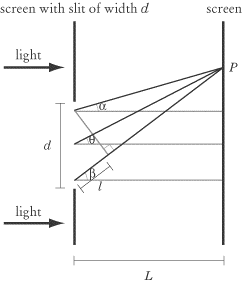
Actually, there are a lot of different paths that light can take to
P—there is a path from any point in
the slit. So really, the diffraction pattern is caused by the superposition of
an infinite number of waves. However, paths coming from the two edges of the
slit, since they are the farthest apart, have the biggest difference in phase,
so we only have to consider these points to find the maxima and the minima.
Single-slit diffraction is nowhere near as noticeable as double-slit
interference. The maximum at n
= 0 is very bright, but all of the other
maxima are barely noticeable. For this reason, we didn’t have to worry about the
diffraction caused by both slits individually when considering Young’s
experiment.
Polarization
Light is a transverse wave, meaning that it oscillates in a direction
perpendicular to the direction in which it is traveling. However, a wave is free
to oscillate right and left or up and down or at any angle between the vertical
and horizontal.
Some kinds of crystals have a special property of polarizing light,
meaning that they force light to oscillate only in the direction in which the
crystals are aligned. We find this property in the crystals in Polaroid disks.
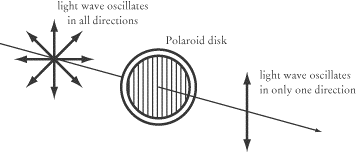
The human eye can’t tell the difference between a polarized beam of light and
one that has not been polarized. However, if polarized light passes through a
second Polaroid disk, the light will be dimmed the more that second disk is out
of alignment with the first. For instance, if the first disk is aligned
vertically and the second disk is aligned horizontally, no light will pass
through. If the second disk is aligned at a 45º
angle to the vertical, half the light will pass through. If the second disk is
also aligned vertically, all the light will pass through.
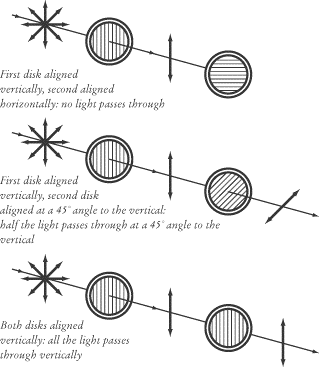
Wave Optics on
Physics
Physics will most likely test your knowledge of wave optics
qualitatively. That makes it doubly important that you understand the physics
going on here. It won’t do you a lot of good if you memorize equations involving
d sin?
but don’t understand when and why interference patterns occur.
One of the more common ways of testing wave optics is by testing your
familiarity with different terms. We have encountered a number of
terms—diffraction, polarization, reflection, refraction, interference,
dispersion—all of which deal with different manipulations of light. You may find
a question or two that describe a certain phenomenon and ask which term explains
it.
Example
|
|
|
Which of the following phenomena does NOT affect the direction of a wave of
light? |
|
(A) |
Dispersion |
|
(B) |
Polarization |
|
(C) |
Diffraction |
|
(D) |
Reflection |
|
(E) |
Refraction |
The answer to the question is B. Polarization affects how a wave of light
is polarized, but it does not change its direction. Dispersion is a form of
refraction, where light is bent as it passes into a different material. In
diffraction, the light waves that pass through a slit then spread out across a
screen. Finally, in reflection, light bounces off an object, thereby changing
its direction by as much as 180°.
Back
Next
Next to display next topic in the chapter.
Practice Questions
Video Lessons and 10 Fully Explained Grand Tests
Large number of solved practice MCQ with explanations. Video Lessons and 10 Fully explained Grand/Full Tests.